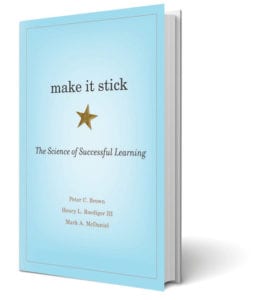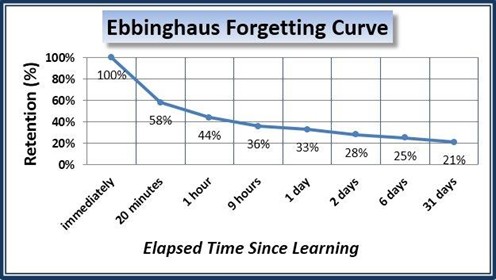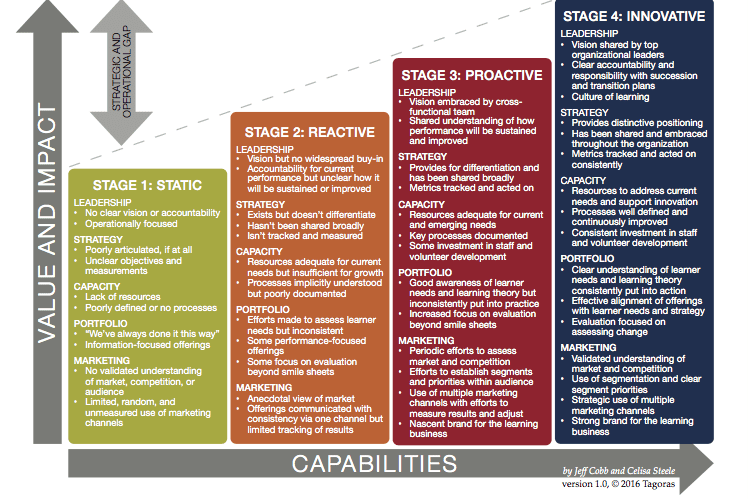For any organization offering learning, learning science is important. But it’s arguably even more important for learning businesses because of the far-reaching impact that can be achieved from effectively applying it.
In this first installment in our “Learning Science for Learning Businesses” new seven-part series, we take a broad look at the science of learning, including related practical insights and key areas of influence for learning businesses. We also preview the specific areas of learning science that we’ll address later in the series and their related implications for creating a thriving learning business.
To tune in, listen below. To make sure you catch all future episodes, be sure to subscribe via RSS, Apple Podcasts, Spotify, Stitcher Radio, iHeartRadio, PodBean, or any podcatcher service you may use (e.g., Overcast). And, if you like the podcast, be sure to give it a tweet.
Listen to the Show
Access the Transcript
Download a PDF transcript of this episode’s audio.
Read the Show Notes
What Is Learning Science?
[00:20] – Saying we’re focusing on learning science invites the obvious but important question “What is learning science?”
The science of learning is an interdisciplinary field devoted to better understanding how learning happens and then applying that understanding to creating and improving instructional methods, curricula, formal and informal learning environments, and more.
In some ways, learning science is a new field in the sense that we’ve become much more conscious of it in the last couple of decades or so, particularly with advances in neuroscience and even in psychology. Implicitly, the whole science of learning has been there for a very long time, but it has the feel of something new, and we felt we really needed to dig into it because it is so important to modern learning and being a modern learning business.
There’s even an association for this: the International Society of the Learning Sciences. One thing to emphasize is the field’s foundation in evidence-based approaches. The science part of the science of learning is that it relies on experiments and studies of what actually works or doesn’t, what actually improves learning or doesn’t.
That evidence-based approach is probably one of the reasons we’re so fascinated with it because that’s consistent with our own bias and how we like to approach learning, how we like to approach business, probably how we like to approach life in general. There’s always just a lot of intuition out there. Intuition can be a good thing, but it often proves to not be our friend. You really do have to test things and figure out what’s actually going to work. Go with your intuitions, obviously trust them to a certain extent, but always verify; always go for that evidence-based approach.
The rigor of the science part of learning science means it can be a bit slow—structuring the studies, writing them up, getting them peer reviewed and published takes time. Even once a study is published about, say, the role of learning objectives in learning, it can be dense. Given rise to a cadre of folks devoted to translating academic research for the practitioners—the designers and teachers and facilitators who are the ones who actually need to know the stuff if learning science is actually going to result in more effective products and experiences.
That cadre of research-to-practice translators includes folks like Will Thalheimer, Patti Shank, Connie Malamed, co-author of Make It Stick: The Science of Successful Learning, Peter C. Brown, and others we’ve had on the podcast in the past.
It also includes folks like Ruth Colvin Clark, whom we’ll talk with for this series, which is exciting as we’ve been big fans of her work for years, especially e-Learning and the Science of Instruction.
Another translator we talk with in this series is Megan Sumeracki, co-founder of The Learning Scientists, who are cognitive psychologists interested in the science of learning. Their vision is to make scientific research on learning more accessible to students, teachers, and other educators.
Learning science has clear implications for those providing learning—and that’s why we have these translators doing the work to bridge academic research with real-world application. For any organization offering learning, learning science is important, but it’s arguably even more important for learning businesses.
There’s widespread recognition now that lifelong learning is so important (see our related episode, The Mainstreaming of Lifelong Learning).
Providing education and learning experiences to adult lifelong learners is obviously at the core of being in a learning business. But, to thrive in that business, you must have impact. You have to move the dial for the learners you’re serving. That’s what learning science helps to guarantee, and it’s just so critical for learning businesses.
Jeff Cobb
See our related episode, One Word: Impact.
Sponsor: SelfStudy
[07:49] – If you’re looking for a partner to help you create and deliver learning experiences using tools grounded in learning science, check out our sponsor for this series.
SelfStudy is a learning optimization technology company. Grounded in effective learning science and fueled by artificial intelligence and natural language processing, the SelfStudy platform delivers personalized content to anyone who needs to learn either on the go or at their desk. Each user is at the center of their own unique experience, focusing on what they need to learn next.
For organizations, SelfStudy is a complete enterprise solution offering tools to instantly auto-create highly personalized, adaptive learning programs, the ability to fully integrate with your existing LMS or CMS, and the analytics you need to see your members, users, and content in new ways with deeper insights. SelfStudy is your partner for longitudinal assessment, continuing education, professional development, and certification.
Learn more and request a demo to see SelfStudy auto-create questions based on your content at selfstudy.com.
Practical Insights from the Science of Learning
[09:10] – To help convey the potential impact of learning science on learning design and the success of learning businesses and their learners, below are some of the practical insights that have come from the science of learning.
- Working memory, cognitive load, and long-term memory. We all have a limited amount of cognitive space to use to engage with and process new information and ideas. That space—typically referred to as working memory—can only hold a few items at any one time. We have to design to focus learners’ working memory on what’s relevant and necessary to learn—so the learner isn’t squandering finite cognitive resources on irrelevant stuff. While we do know that that learning needs to be effortful to stick, that’s not the kind of effort that you want people to make. You don’t want them to have to deal with overload. You want to ease that path to moving that information, the new knowledge that they’re acquiring, from short-term memory, working memory, into long-term.
To learn more, check out our interview with Dr. Patti Shank, author of Manage Memory for Deeper Learning (*see transcript for specific excerpt referenced).
[14:10] –
- Effort and spacing. Combining these is so important. Spacing is the idea that you don’t encounter content or practice something just once, rather you do it repeatedly over time with some space in between. We think a lot of learning scientists/learning theorists would agree that it’s one of the most powerful ways to make sure that learning sticks.
To learn more, check out our interview with Peter C. Brown, co-author of Make it Stick: The Science of Successful Learning (*see transcript for specific excerpt referenced).
Brenda McLaughlin, CEO of SelfStudy also shares how they see a growing understanding in the market of the benefits of some of these science-based practices such as personalization, spacing, and repetition.
[18:40] – The interesting thing is that a lot of the big takeaways from learning science aren’t new discoveries—personalization, spacing and repetition and effort, the role of memory. None of that’s new. The Ebbinghaus forgetting curve—which shows that we forget the vast majority of what we “learn”—has been around since the 1880s.
Our understanding, of course, is deepening now, and it’s becoming more nuanced. Also, the pandemic was a sort of petri dish in this past year because we had to scramble so quickly to get online and figure out how to make learning effective in an environment that many organizations hadn’t focused on as much as they should have before.
Key Areas of Learning Science’s Influence
[20:17] – Learning science plays a direct role in a learning business’s portfolio of products. And portfolio is one of the 5 domains we identified in the Learning Business Maturity ModelTM. Having a good understanding of learning science plays into a learning business’s capacity too—having staff who and technology that understand and make use of learning science is great. And good learning science will help with marketing, and it can—and arguably should—factor into a learning business’s strategy, and having leadership tuned in is key too. But the most direct role is in portfolio.
In this series we want to look at some of the key aspects of learning science, and we’ll pull in other experts and draw on conversations for perspective. We’ll focus on:
- Behavioral and cognitive psychology
- Needs assessment
- Content
- Feedback and practice
- Evaluation
[25:05] – Of course, all of this is important in general. But getting it right is really at the core of being an effective learning business, being a learning business that’s going to be able to not just survive but thrive in the current world.
Learning science will also help your learning business:
- Stand out in a crowded marketplace
- Improve reach, revenue, and impact
- Have an impact on the learning businesses ecosystem
[28:15] – Wrap-up
Highlighted Resources:
A wealth of resources exists for keeping up with evidence-based practice ideas. We’ll share some specific ones over the course of this series but to avoid overwhelming you we’ll just highlight two now:
- For a more in-depth resource, we suggest Make It Stick: The Science of Successful Learning.
- For a quicker-hits resource, and one that’s freely and immediately available, check out Six Strategies for Effective Learning from The Learning Scientists.
As you look at those six strategies, think about which your learning business might benefit from using more?
To make sure you don’t miss the remaining episodes in the series, we encourage you to subscribe via RSS, Apple Podcasts, Spotify, Stitcher Radio, iHeartRadio, PodBean, or any podcatcher service you may use (e.g., Overcast). Subscribing also helps us get some data on the impact of the podcast.
Impact is as important for podcasting as it is for learning. We’d also appreciate if you give us a rating on Apple Podcasts by going to https://www.leadinglearning.com/apple.
We personally appreciate your rating and review, but more importantly reviews and ratings play a big role in helping the podcast show up when people search for content on leading a learning business.
Finally, consider following us and sharing the good word about Leading Learning. You can find us on Twitter, Facebook, and LinkedIn.
[32:30] – Sign off
Episodes on Related Topics:







 Digital Transformation: It’s All About Culture
Digital Transformation: It’s All About Culture
Leave a Reply